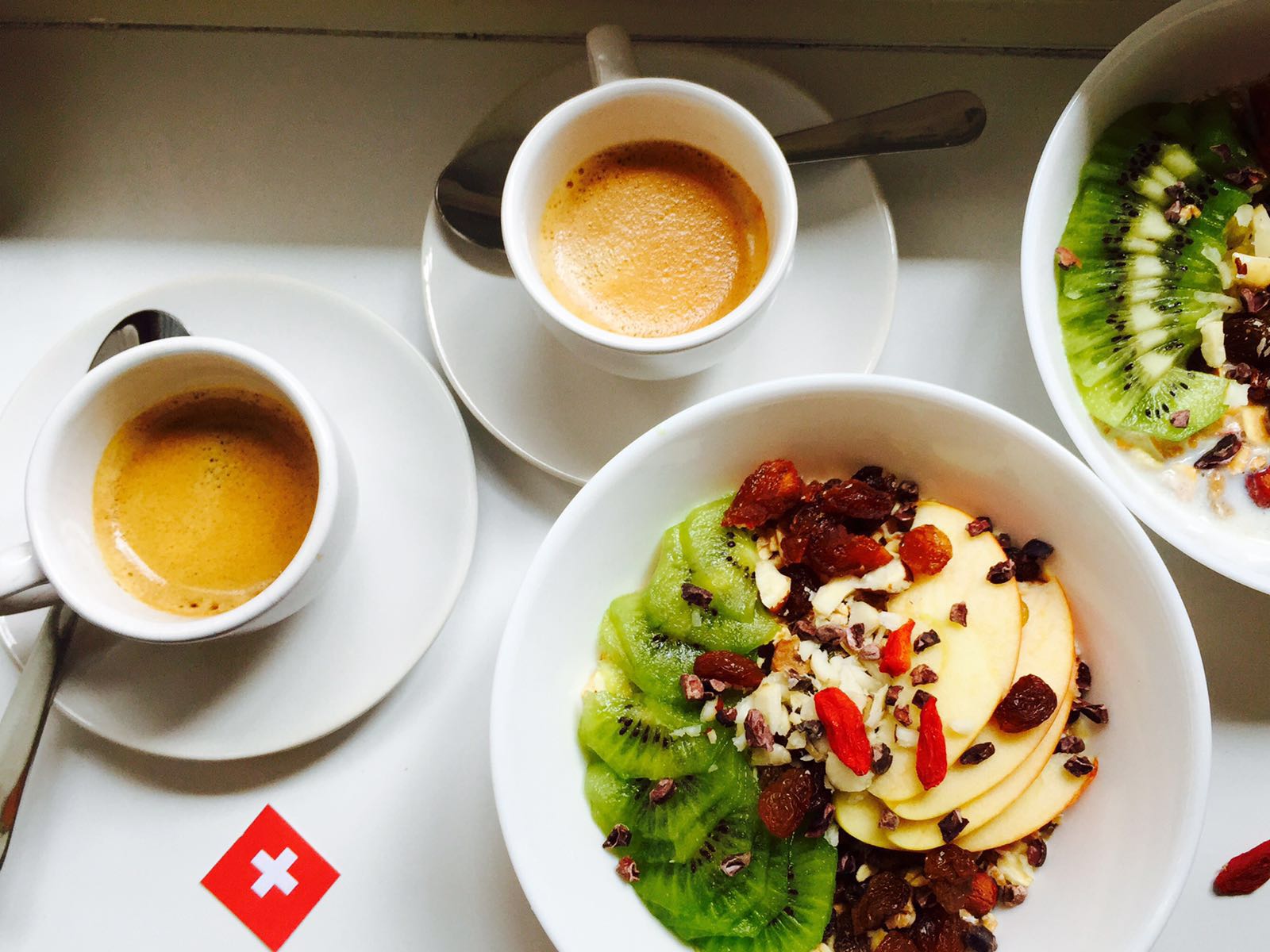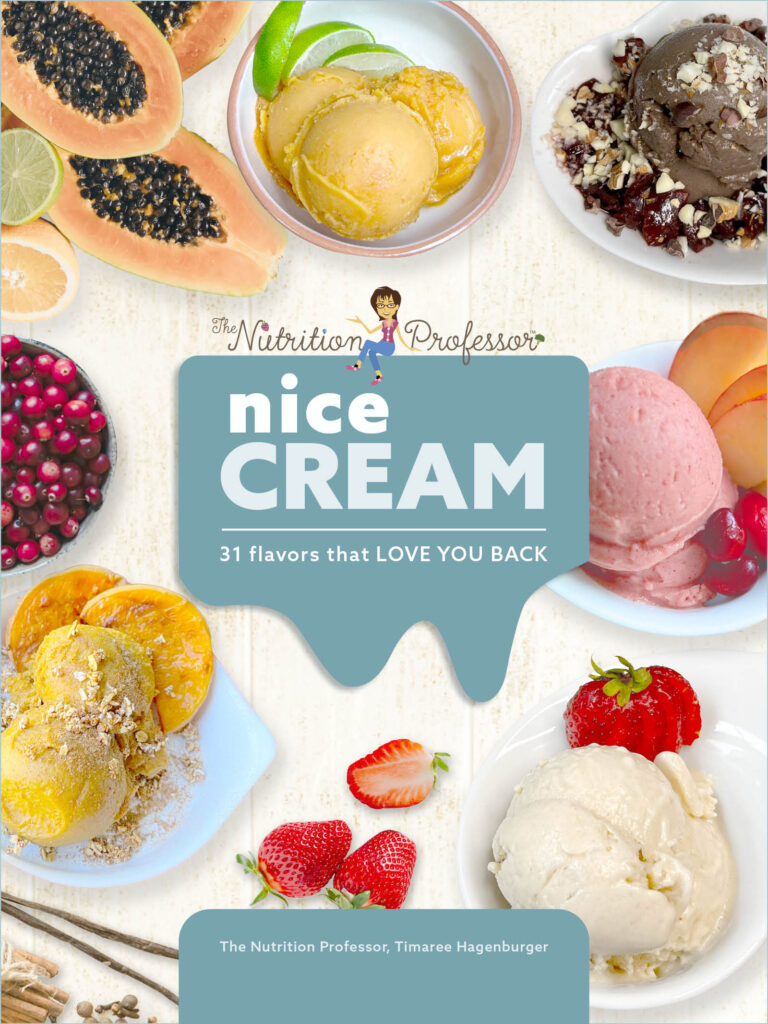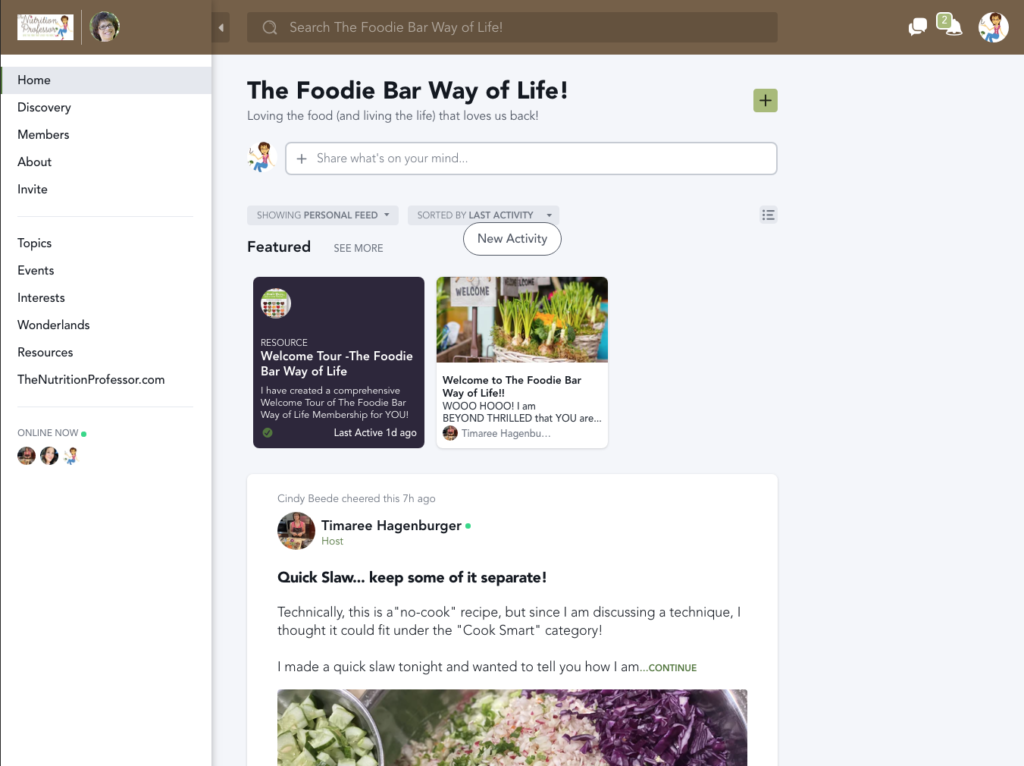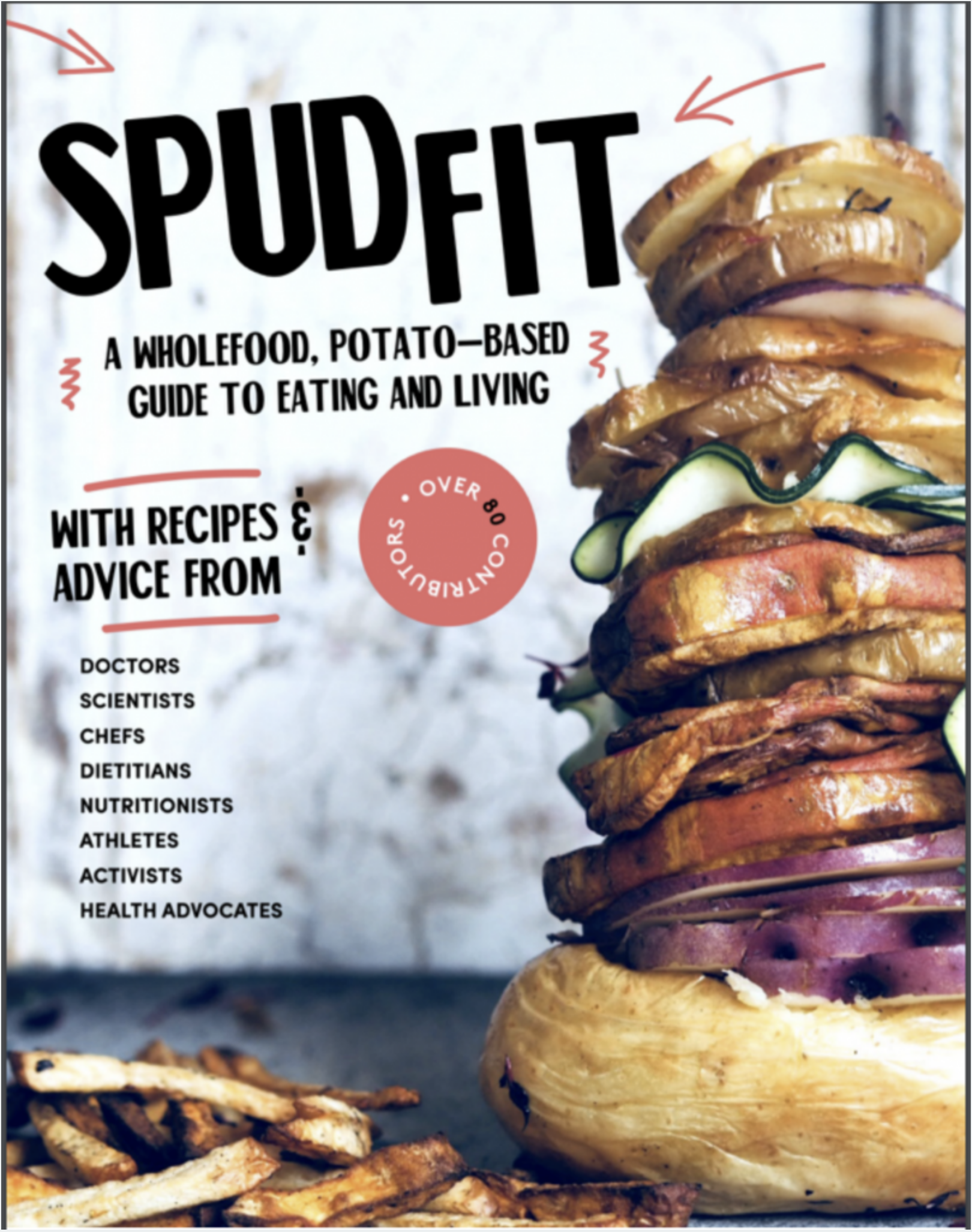Why not experiment with a different breakfast option? Mornings can get pretty hectic and many people find this part of the day anything but fun, especially when it comes to food, whether they have kids or not. Valentina Bianchi, one of my students from Switzerland, and I are on a mission to change that. You get to learn from her about health and family traditions, and we invite you to play around with a traditional Swiss recipe, Foodie BarTM style (with everyone combining the ingredients they enjoy most). Before we hear from Valentina, I wanted to share a little update: This recipe was such at hit at one of our cooking demos last semester, that many students still make it all of the time! From Valentina…
Having grown up in Switzerland, I was concerned about healthy food since I was a child, as I had been suffering from various health issues for several years. Foods such as cured meat, cheese, and wine are common ingredients that are found in almost any traditional Swiss dish. I soon came to realize that this typical Swiss diet could not be good for us. Old meat, old milk (cheese), and old grape juice (wine) not only made me feel older but also sicker. Furthermore, as the United Nations has shown, the production of such foods, particularly those that require animal husbandry, is also harmful for the environment.
During my studies in Traditional Chinese Medicine and Dietetics in Switzerland, I learned that old cured food may have helped farmers to make it through hard winters, but certainly do not serve us if we are seeking to enjoy optimal health. Saturated fat, salt, and histamines (all found in cured foods) clog our vessels, raise our blood pressure, contribute to obesity, give us headaches, and make us tired. Eating fresh, plant food changed my life profoundly. I am never really sick, all of my health related issues and symptoms have disappeared, my mind is fresh, and I feel vital.
My transition to a whole food, plant-based way of eating did not happen overnight. At first, it was challenging to re-imagine our customs and family traditions, but in my experience, I know it can be done. In my family, everyone appreciated when I took over the cooking role and the more I cooked plant-based meals, the more they wanted to know about my lifestyle. Day by day, we all changed our old eating habits together, and it became easy. We are now a team and it is fun to prepare food together and experiment in the kitchen. Even my father, who owns one of the biggest fish and meat distribution companies in Switzerland, brings blocks of tofu to BBQ parties for us from his company.
I think that cured is “old news” and fresh is what makes sense for today and into the future. If “fresh” and energized is how we want to feel now, we need to be open to new ways of nourishing ourselves. But how can we break free from social pressure to eat a certain way? And, how can we opt out of consuming meat, dairy, and other processed foods that compromise our health? I believe that the answer is simple. We make “fresh” our new normal. We buy fresh food from the markets and prepare fresh food for our friends and family. We do not need to start a revolution, we just help our own families and friends be healthy by sharing only the best, healthiest, tastiest and freshest food. That’s how we start. In my experience, when we do so, people begin to ask for recipes. When they do, I proudly list off all of the amazing and healthy ingredients. This seems to be quite contagious, as others readily become inspired and want to do the same. The more confident we are in this transition, the less people will doubt what we are doing.
Why not preserve important traditions by reinventing a favorite recipe to enjoy with your friends and family? The internet can be a wonderful resource for finding substitutions for ingredients, creative blogs and delicious recipes. I prepared a famous Swiss dish called “Brichermüesli” (or “Müesli”) as a cooking demonstration for our Thrive On Plants Club at Cosumnes River College. “Birchermüesli” was originally invented by Max Bircher; a doctor, reformer, and dietitian who promoted a whole food diet in the late 19th century. By 1940, “Birchermüesli” was found on every Swiss table as a breakfast or dinner meal, or snack. I often enjoy it for breakfast because it is cheap, easy to prepare, I love every bite and feel great after eating it. I like sharing it with others of all ages, as many are surprised that it can be so delicious without sugar and dairy. I can bring it to a Swiss brunch without taking anything away from our tradition.
Valentina’s Müesli Foodie BarTM
Ingredients for Muesli base*:
2 cups oats*
½ cup raisins or other dried fruit
water or plant-based milk* (enough to just cover oats)
Combine and let sit covered in the refrigerator overnight. *Designate someone in the house to be the “base maker“ before heading to bed.
In the morning, stir in:
3 apples with skin (grated)
1 lemon (zest and juice)
Fun and Flavorful Mix-ins: (invite everyone to experiment with different combinations)
· fresh or frozen fruit (kiwi and berries are amazing)
· nuts and/or seeds (Valentina likes roasted walnuts)
· dried fruit (chopped dates add a “caramel-ish“ sweetness)
· cacao nibs
· shredded coconut (unsweetened)
· cinnamon (or your favorite spice blend – Chai is nice!)
· additional plant-based milk
Valentina’s Mango “Yogurtˮ:
Add dried mango to any plant-based milk* – let it soak for at least 30 minutes before combining it in a food processor or blender.
This Müesli is packed with super foods, vitamins, minerals, antioxidants, healthful fats, and lots of fabulous fiber. Oats are good for your heart and gut, while apples with their skin and lemon zest boost our cells̕ ability to prevent and shut down cancer. Could there be a better way to start your day and have it your way?
The Nutrition Professor’s Shop Smart, Prep Smart, Eat Smart Tips:
*For the oats, I like using old-fashioned (5-minute) oats – organic and sprouted if you can find them or quick cooking steel-cut oats. “Regular” steel-cut oats can be used, but due to the texture, may not soften to your liking. If they are “too crunchy” when you are ready to eat, simply add some extra water to the muesli and it cook on the stove!
*While any plant-based milk can be used, I typically opt for unsweetened, organic soy milk or almond milk (or a combination), as I want the sweetness to come from the fruit in the recipe and benefits from the phytonutrients in soy.
*For the “mango yogurt” – Be sure the milk completely covers the fruit while soaking. Start with just enough of the soaking liquid in the blender to get the fruit pureed and add more per your preference. I like it thin enough to pour.
*The muesli will last for several days in the refrigerator. I put it toward the back to help keep it cold, as family members tend to open and close the fridge quite often!
Timaree Hagenburger, a plant-based registered dietitian nutritionist (RDN), certified exercise physiologist with a master’s degree in public health, has over 20 years of experience as a nutrition professor. She is a sought after speaker, media personality and author, who works with private clients, and in corporate wellness, has contributed to several cookbooks and published her own cookbook, The Foodie Bar Way: One Meal, Lots of Options, Everyone’s Happy (www.foodiebars.com)! Timaree is also the founder of an incredible online membership community, The Foodie Bar Way of Life, that makes loving the food (and living a life) that loves us back… simple, satisfying, sustainable AND FUN! You can contact her about working with her through 1:1 dietitian nutrition coaching, for hands-on cooking instruction and to inquire about arranging a speaking engagement.


 Order and learn more at www.FoodieBars.com
Order and learn more at www.FoodieBars.com

 This is a first for me... Some of MY recipes are part of a rock star compilation cookbook put together by Andrew Spud Fit Taylor!! Order it today!
This is a first for me... Some of MY recipes are part of a rock star compilation cookbook put together by Andrew Spud Fit Taylor!! Order it today!
This bowl of morning goodness looks absolutely delicious! Thank you for the yummy breakfast idea!
Looks beautifully appetizing. Love the mango yogurt idea!
Thank you
How many servings is this?
The number of servings will depend on how many add-ins are incorporated and how much each person consumes (our hunger varies from day to day, as well)… not an easy question to answer!
This looks great but wondering what is a good substitute for oats (they make me itch)?
You could substitute bulgur or quinoa flakes (not cereal, but flattened quinoa), or just increase the chia (and add flax meal). My Mango Chia Pudding would be a great recipe to try, too! https://thenutritionprofessor.com/3234-2/